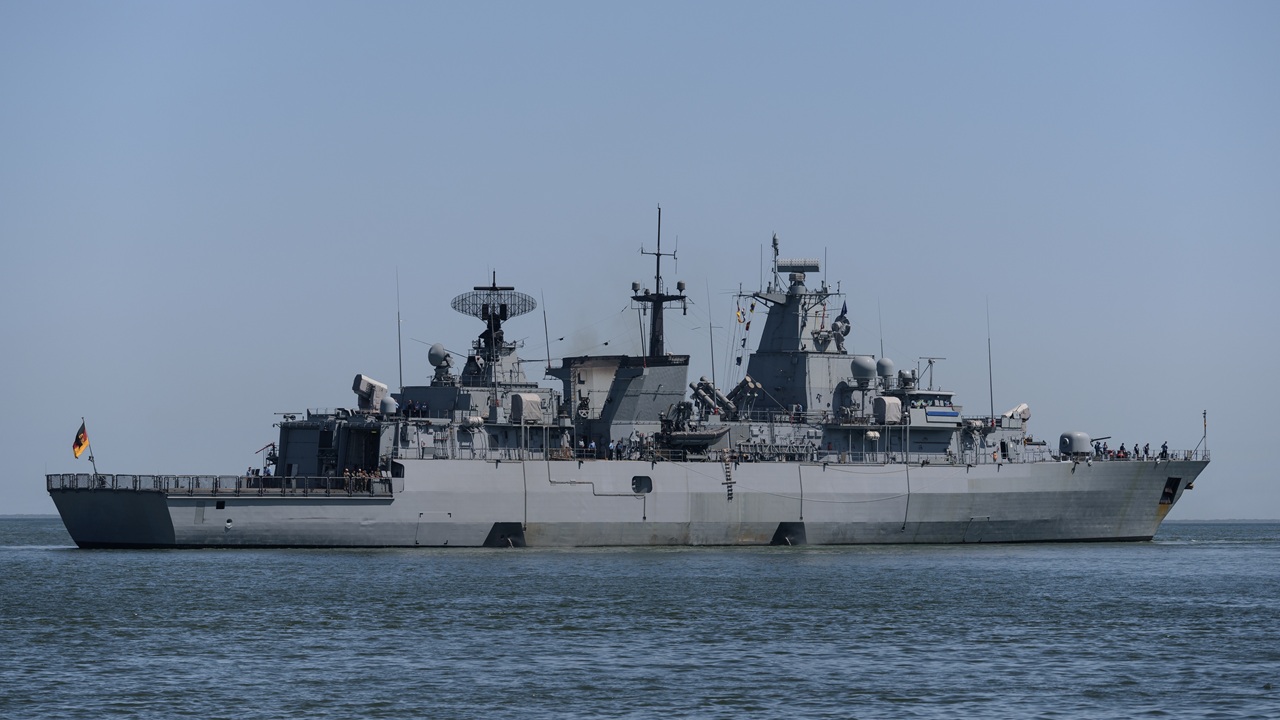Politics
German Navy Advances Laser Weapon Testing for Modern Warfare

The German Navy is taking significant steps towards operationalizing a new laser weapon system designed to counter various aerial threats. After a year of rigorous testing aboard the Sachsen frigate, the directed energy weapon has demonstrated its capabilities against a range of targets, including guided missiles, rockets, and drone swarms. This advancement marks a notable shift in naval warfare, particularly in response to increasing threats faced by NATO forces.
According to Rheinmetall, in collaboration with MBDA, the laser weapon system has undergone over 100 live firing trials, showcasing a high degree of accuracy and reaction speed. The successful tests on the Sachsen frigate are the first of their kind in Europe, confirming the system’s tracking capability and effectiveness under real operational conditions. “Successful tests conducted on the frigate Sachsen proved the demonstrator’s tracking capability, effectiveness, and precision under real operational conditions for the first time in Europe,” Rheinmetall stated in a press release.
The newly tested laser weapon system is capable of engaging a variety of targets, including unmanned aerial vehicles (UAVs), artillery shells, and even speedboats. Rheinmetall emphasized that this directed energy weapon offers advanced possibilities for countering non-cooperative threats, stating that it successfully engaged targets without needing terrain as a backstop, a scenario described as “in front of blue sky.”
Technical Specifications and Strategic Importance
This laser weapon operates at a power of 20 kilowatts, making it particularly effective against smaller threats, such as drones. The system can be upgraded to higher power levels, allowing it to intercept larger targets if required. The significance of this technology is underscored by recent challenges faced by US and NATO warships in the Red Sea, where Yemen-based Houthi insurgents have increased their attacks on maritime traffic, posing a substantial threat to one of the world’s most vital trade routes.
The operational capabilities of the laser system are a response to evolving threats in naval warfare. With the rise of low-cost drone technology, traditional kinetic munitions have become economically unsustainable for engaging such targets. The cost efficiency of directed energy systems is striking; for instance, while a MIM-104 Patriot missile can cost around $3 million, and a RIM-161 SM-3 missile up to $30 million, a single shot from a laser weapon is estimated to cost around $10. This dramatic difference highlights the potential for laser systems to provide a more sustainable solution for naval defense.
As Rheinmetall continues to refine the system, it also emphasizes the collaborative efforts involved in its development. MBDA is primarily responsible for target detection and tracking, while Rheinmetall manages the aiming system and high-energy laser source integration on naval vessels. This partnership aims to ensure that the German Navy is equipped with cutting-edge technology to address modern threats effectively.
Future Implications for Naval Warfare
The testing and eventual deployment of laser weapon systems could redefine engagement strategies for naval forces globally. As nations enhance their defense capabilities, the German Navy’s advancements in directed energy weapons offer a glimpse into the future of military technology. Rheinmetall noted that achieving operational readiness for the German Navy is a crucial step towards establishing a robust defense against evolving threats.
As the global security landscape continues to change, the integration of laser weapon technology into naval operations could provide a significant advantage. With the ability to engage multiple targets at a fraction of the cost of traditional weaponry, the German Navy is poised to lead in the next generation of naval warfare. The implications of this technology extend beyond national defense, potentially influencing NATO’s collective response to maritime threats in the coming years.
-

 Lifestyle1 week ago
Lifestyle1 week agoSend Holiday Parcels for £1.99 with New Comparison Service
-

 Science2 months ago
Science2 months agoUniversity of Hawaiʻi Leads $25M AI Project to Monitor Natural Disasters
-

 Science2 months ago
Science2 months agoInterstellar Object 3I/ATLAS Emits Unique Metal Alloy, Says Scientist
-

 Science2 months ago
Science2 months agoResearchers Achieve Fastest Genome Sequencing in Under Four Hours
-

 Business2 months ago
Business2 months agoIconic Sand Dollar Social Club Listed for $3 Million in Folly Beach
-

 Politics2 months ago
Politics2 months agoAfghan Refugee Detained by ICE After Asylum Hearing in New York
-

 Business2 months ago
Business2 months agoMcEwen Inc. Secures Tartan Lake Gold Mine Through Acquisition
-

 Health2 months ago
Health2 months agoPeptilogics Secures $78 Million to Combat Prosthetic Joint Infections
-

 Lifestyle2 months ago
Lifestyle2 months agoJump for Good: San Clemente Pier Fundraiser Allows Legal Leaps
-

 Science2 months ago
Science2 months agoMars Observed: Detailed Imaging Reveals Dust Avalanche Dynamics
-

 Health2 months ago
Health2 months agoResearcher Uncovers Zika Virus Pathway to Placenta Using Nanotubes
-

 Entertainment2 months ago
Entertainment2 months agoJennifer Lopez Addresses A-Rod Split in Candid Interview









